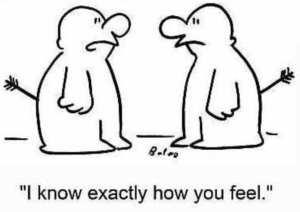In my previous blog, I suggested that to live and work with a mindset of innovation is a POETIC way to approach life. POETIC is my acronym for People (empathy), Optimism, Experimentation, Tension, Idea, and Collaboration. This blog explores the People part of innovation, which is about empathy.
All educators recognize the name Maria Montessori. Montessori Schools are the result of a single idea that came through the thought processes of innovation, as Montessori took an empathetic view of how children learn and develop. How did her transformational idea come about? By thinking empathetically about others.
Montessori asked herself, If I were a child, how would I react if every time I tried to manipulate my environment, the means to do so were taken away from me? How would I respond to school where I hoped to learn by doing, only to find that I must sit still and listen or watch rather than trying things out for myself? How would it be if I were constantly controlled by those around me, like a little doll, allowed to do nothing on my own because I might act too slowly or incorrectly?
Montessori tells the story of a six month old baby girl. The infant is given a rattle, which she drops over and over. Montessori observed that the little girl wasn’t watching the rattle as she released it. What the child was watching was the capability of her own tiny hands. On closer scrutiny, Montessori noticed that the baby systematically varied the activity, dropping or not dropping the rattle as she opened a single finger at a time. After the baby’s mother grew frustrated at having to pick up the toy repeatedly and took it away, the baby cried. But this reaction was not simply a control-related tantrum: the baby was expressing frustration at not being able to complete her experiment.
Montessori’s ideas grew larger at every stage:
1) There might be something about the environment that delayed child development.
2) Education could impact advancement among normal children.
3) Self-learning among children suggested an approach to instruction that was more child-centric.
4) Morality evoked an educational system grounded in the child’s right to respect and dignity.
Maria read everything published over the former 200 years on educational theory. She visited London and Paris to see if anyone there was training mentally deficient children. There was nothing published or taking place for her to draw from. So, when she returned to Italy she founded the country’s first state Orthophrenic school. Mentally challenged children were brought for two-year stints to live and study under methods Montessori had developed. The results were staggering. Most students attained unimaginable developmental milestones; many passed the state examinations taken by normal children.
The Montessori Method is rooted in respect for children. At a time when children sat on hard benches listening silently all day to a single teacher’s recitation and were punished for any infraction of the rules, her methods were earth-shattering. No longer was the child dependent and subservient. Montessori argued that children’s natural impulses should not be suppressed; their natural hunger to learn should be nurtured and exercised. Toys were replaced with child-sized tools, and children did tasks such as cleaning and cooking. Students taught themselves through self-exploration or were taught by older students. The teacher remained in the shadows, coming out only as needed as a non-directive guide.
Today there are an estimated 20,000 Montessori schools. Montessori preschool students have been shown to out-perform traditional students on standardized tests of reading and math, and also possess advanced social skills. Older Montessori students have reported a greater sense of motivation and community than students from other schools. In a randomized comparison, Montessori pupils also wrote noticeably more creative essays.
Empathy toward another person may not sound like the most exciting tool towards innovation, but Montessori teaches us that it is a tool that can be used to transform. When you look at your ensemble, or when you look at your audience, do you see them as musicians only? What would happen if you viewed them through a mindset of empathy? When you look at those attending your programs and concerts, do you see them only as an audience? What would happen if you viewed them with an empathetic lens? Viewing those that surround you in your work empathetically is the starting place for innovation.



Andrey Luchnik says
Interesting discussion. I am rather English than American.
So looking into Webster’s Collegiate Dictionary, I read: EMPATHY: – “the imaginative projection of a subjective state into an object so that the object appears to be infused with it”.
So, BREXIT is OK. This is an exit from the spoiled English.